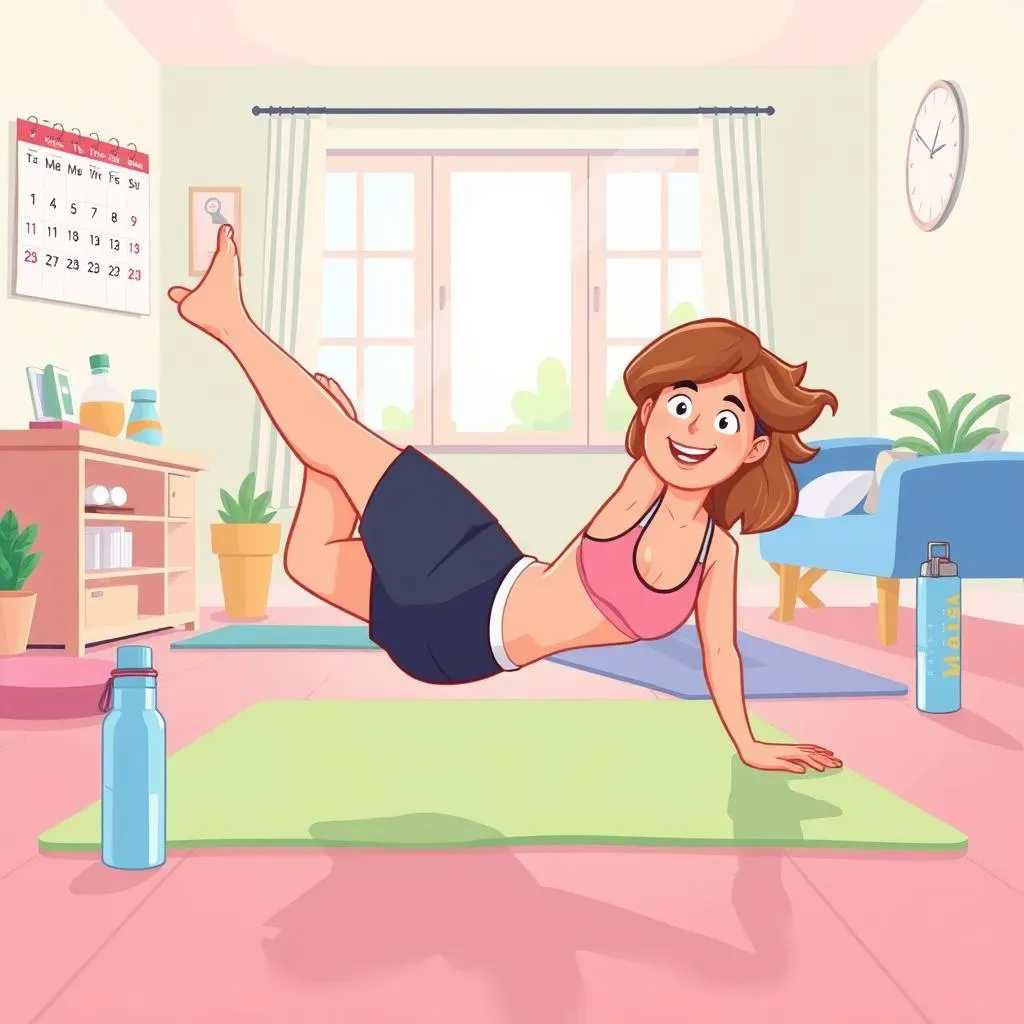Table of Contents
Tired of crunches that make your neck ache? Want a strong core without the strain? You're in the right place! This article is your guide to effective low impact core workouts at home. Forget those high-flying, jarring exercises; we're focusing on moves that are kind to your body while still delivering amazing results. We’ll explore why a strong core is so important, not just for a six-pack, but for overall health and stability. We’ll then walk through specific exercises you can do right in your living room, no fancy equipment required. Finally, we’ll help you build a routine that fits your schedule and goals. Get ready to discover how you can build a powerful core with these gentle, yet effective low impact core workouts at home. Let's get started on this journey to a stronger, more stable you!
Why Low Impact Core Workouts at Home?

Why Low Impact Core Workouts at Home?
Okay, so you're probably wondering, why even bother with low impact core work, right? I get it. We often think core work means grueling crunches and planks that leave you feeling like you’ve been hit by a truck. But here's the thing: your core isn't just about having a washboard stomach. It’s the powerhouse of your body, the center of all your movements. Ignoring it or overdoing it with high-impact stuff can cause more harm than good. Low impact workouts are like giving your core a gentle hug instead of a harsh shove. They strengthen those deep muscles that support your spine and improve your posture, all without stressing your joints. Think of it as building a strong foundation for a house, you wouldn't start with a jackhammer, would you?
Plus, let's be real, life's busy. Who has time to trek to the gym for an intense core session? The beauty of low impact core workouts at home is that they're super convenient. You can squeeze them in whenever you have a few minutes, in your pajamas if you want! No fancy equipment is required, you’re using your own body weight. It’s all about being smart with your movements, not about how hard you can push yourself. It's about consistency, not intensity. And the best part? These exercises are totally scalable, meaning they’re perfect whether you’re a beginner or a seasoned fitness enthusiast. I’ve been doing them for years now, and I still feel the burn, just without the joint ache.
Benefit | Description |
|---|---|
Joint-Friendly | Reduces stress on knees, hips, and back. |
Convenient | Can be done anywhere, anytime, no equipment needed. |
Scalable | Suitable for all fitness levels. |
Effective | Strengthens core muscles, improves posture, and reduces back pain. |
Effective Exercises for Your Low Impact Core Workouts at Home

Effective Exercises for Your Low Impact Core Workouts at Home
The Gentle Giants:
Core Activation Moves
Alright, let's get into the good stuff – the exercises! When we talk about low impact, we’re not talking about easy, we’re talking about smart. We need to wake up those core muscles before we start challenging them. Think of these moves as the warm-up before the main event. One of my favorites is the pelvic tilt. Sounds simple, right? Just lie on your back, knees bent, and gently rock your pelvis back and forth. It’s like a tiny dance for your lower back, and it's fantastic for activating those deep core muscles. Another great one is the dead bug. You’ll be on your back, arms and legs up, and then you slowly lower one arm and the opposite leg, keeping your core tight. It’s harder than it looks, trust me! These are the kind of movements that teach your core to work correctly, setting you up for success in all your other exercises.
Building Strength:
Core Strengthening Exercises
Now that our core is awake, let's build some strength! We’re not going to be doing any crazy sit-ups here. Instead, we'll focus on exercises that engage the entire core, not just the surface muscles. Bird dogs are fantastic; you’re on your hands and knees, extending one arm and the opposite leg. It's like a balancing act, but it really works your core. Then there's the plank, a classic for a reason. But instead of just holding it for dear life, try variations like forearm planks or plank taps to increase the challenge. I’m a big fan of side planks too, they hit those obliques and help stabilize your spine. Remember, it's all about control and proper form, not about speed or reps. Feel the burn, but don't let your form break down.
Exercise | How To | Why It Works |
|---|---|---|
Pelvic Tilts | Lie on back, rock pelvis gently. | Activates deep core muscles. |
Dead Bug | Opposite arm & leg lowers slowly. | Teaches core control and stability. |
Bird Dog | Extend opposite arm and leg on all fours. | Strengthens core and improves balance. |
Plank | Hold a straight line from head to heels. | Strengthens entire core, improves stability. |
Side Plank | Hold body on its side, supported by one arm. | Targets obliques, improves spinal stability. |
The Finishing Touches:
Core Stability Moves
Finally, let's talk stability. This is where we challenge our core to work in a more dynamic way, helping you in your everyday movements. Try the modified mountain climber. Instead of running your knees in, go slowly and maintain control, focusing on keeping your hips stable. Another great one is the slow bicycle crunch. Again, we’re not trying to set any speed records here. It’s about slow, controlled movements. Focus on engaging your core as you twist. These stability moves help your core become more resilient, so you can move with more confidence and less risk of injury. I always try to incorporate these kinds of exercises into my routine, and it’s made a huge difference in how I feel during daily activities. It’s all about building a core that’s not just strong, but stable and resilient.
Building a Routine for Low Impact Core Workouts at Home

Building a Routine for Low Impact Core Workouts at Home
Start Slow and Steady:
Finding Your Rhythm
Okay, so you've got all these great exercises, but how do you actually fit them into your life? It's tempting to go all-in, but trust me, that's a recipe for burnout. Start slow, like really slow. I'm talking two or three times a week, maybe 15-20 minutes each time. The goal is to make this a sustainable habit, not a grueling chore. Think of it as dating your core, you wouldn't rush into marriage, would you? Pick a time that works for you, whether it's first thing in the morning or during your lunch break. Consistency is way more important than intensity at this stage. And don't worry if you can't do all the moves perfectly right away. It's a process, and you'll get better over time. I remember when I first started, I could barely hold a plank for 10 seconds, now I can do it for a minute. It's all about showing up and being patient with yourself.
Mix It Up:
Adding Variety
Once you've got a routine going, don't be afraid to mix things up! Doing the same exercises every single time can get boring, and your body might adapt too quickly. So, try swapping out a couple of exercises each week, or play around with the order. Maybe one day you focus more on core activation, and the next you do more strength moves. You can even throw in some extra core stability exercises. Think of it like creating a playlist for your workout, you don't want to listen to the same songs all the time, right? This will keep your workouts fresh and engaging, and it will challenge your core in different ways. It's about listening to your body and finding what feels good and effective for you. I personally enjoy mixing in some yoga-inspired moves on some days, just to keep things interesting.
Routine Tip | Description |
|---|---|
Start Slow | Begin with 2-3 sessions per week, 15-20 minutes each. |
Be Consistent | Regularity is key for building a habit. |
Mix it Up | Vary exercises to keep workouts engaging and effective. |
Listen to Your Body | Adjust the routine based on how you feel. |
Listen to Your Body:
Staying Attuned
Last but not least, always listen to your body. If something feels wrong, stop. Pushing through pain is never a good idea. It's better to take a break or modify an exercise than to risk an injury. Remember, this is about building a stronger and healthier you, not about pushing yourself to the limit every time. Some days you’ll feel like a superhero, and other days you’ll feel like you need to take it easy. That's totally normal. The key is to be in tune with what your body needs. I find that journaling about how I feel after workouts helps me to track my progress and understand what works best for me. And remember, it's a marathon, not a sprint. So, be patient, be kind to yourself, and enjoy the journey of building a stronger core with these low impact core workouts at home. You've totally got this!
